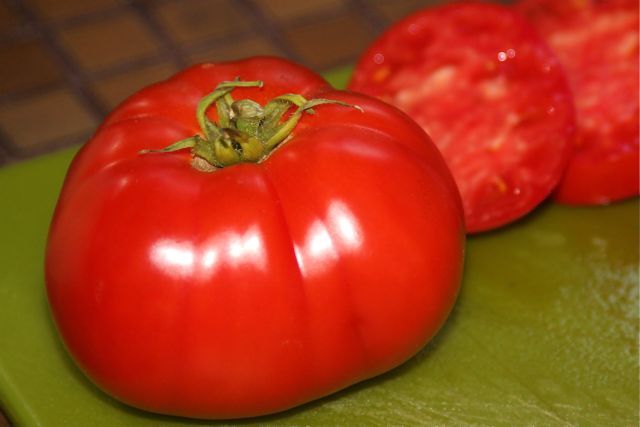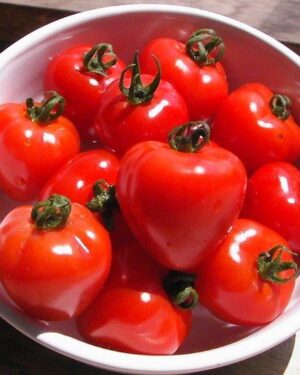Description
Tomato Delicious
Tomato Delicious. The current holder of the world record for the largest tomato at 7lb 12oz. Fruits average 1lb each with a meaty texture with few seeds and an excellent strong tomato flavour, ideal for salads and slicing. Suitable for both indoor and outdoor cultivation. Indeterminate. 80-85 days from germination.
Cultivation Advice
- Choose well-draining soil enriched with organic matter. Amend the soil with compost before planting to provide essential nutrients.
- Aim for a slightly acidic to neutral pH level (around 6.0 to 7.0).
- Start seeds indoors 6-8 weeks before the last expected frost date. Transplant seedlings outdoors when they have a few sets of true leaves and all danger of frost has passed.
- Plant in a location that receives full sunlight, at least 6-8 hours per day.
- Tomato Delicious plants produce large, heavy fruit, so provide sturdy support structures such as cages or stakes to prevent the plants from toppling over.
- Install support structures at the time of planting to avoid damaging the roots later.
- Maintain consistent soil moisture. Tomatoes prefer even watering to prevent issues like blossom end rot.
- Water at the base of the plant to minimize the risk of fungal diseases. Drip irrigation or soaker hoses can be beneficial.
- Prior to planting, incorporate a balanced fertilizer into the soil. Side-dress with additional fertilizer when the first fruits set.
- Avoid excessive nitrogen, which can lead to excessive foliage growth at the expense of fruit production.
- Apply a layer of organic mulch around the plants to conserve moisture, suppress weeds, and regulate soil temperature.
- While indeterminate varieties like Tomato Delicious can be pruned, it’s not always necessary. If you choose to prune, focus on removing suckers and excess foliage to improve air circulation.
- Some gardeners prefer to prune to a single or double stem for better fruit production.
- Regularly inspect plants for signs of diseases, such as early blight or powdery mildew. Provide good air circulation by spacing plants properly and pruning as needed.
- Consider using disease-resistant varieties to minimize the risk of certain tomato diseases.
- Harvest tomatoes when they have reached their full color and are slightly soft to the touch. Fully ripened tomatoes on the vine often have the best flavor.
- Be gentle when harvesting to avoid damaging the fruit or the plant.
- Consider planting basil, marigolds, or nasturtiums nearby to help deter pests that commonly affect tomatoes.
- Avoid planting tomatoes near potatoes or peppers, as they are susceptible to similar pests and diseases.
- Provide protection during unexpected late frosts. Cover plants with frost blankets or similar materials to prevent damage to young fruit.
- In hotter climates, consider providing some shade during the hottest parts of the day.
- Store harvested tomatoes at room temperature until fully ripened. Once ripe, you can refrigerate them to extend their shelf life.
- Understand the specific characteristics of Tomato Delicious. It’s known for its large size and rich flavor, making it a popular choice for slicing and fresh eating. Tailor your care based on the unique traits of this variety.
- While tomatoes thrive in warm weather, they can suffer in extreme heat. Provide shade during scorching days to prevent sunscald on fruits and ensure that the plants receive adequate water.
- Mulching around the base of the plants can also help regulate soil temperature.
- Consistent watering is crucial, especially during periods of fruit development. Inconsistent watering can lead to issues like fruit cracking.
- Regularly check and adjust tomato cages or other support structures as the plants grow. Heavy clusters of tomatoes can weigh down branches, and proper support prevents breakage.
- Know whether Tomato Delicious is a determinate or indeterminate variety. Determinate varieties produce fruit on a more compact bush and tend to have a concentrated harvest, while indeterminate varieties produce fruit continuously throughout the season.
- Consider thinning out excessive fruit clusters if they are too close together. This allows the remaining fruits to develop to their full size and improves air circulation.
- If you’re experiencing a late-season with warm temperatures, you might get additional tomatoes. Keep an eye on the weather and continue to water and care for your plants as long as conditions permit.
- To prevent blossom end rot, ensure a consistent supply of calcium in the soil. This can be achieved by adding lime before planting or using calcium-rich amendments.
- Regularly inspect your plants for signs of common tomato pests such as aphids, hornworms, or whiteflies. Early detection allows for effective control.
- If you want to save seeds for the next season, choose healthy, fully ripe tomatoes for seed collection. Ferment the seeds before drying and storing them.
- Consider using natural predators like ladybugs or releasing parasitic wasps to control common pests. Neem oil or insecticidal soap can also be effective against certain insects.
- Keep a gardening journal to record your observations, including planting dates, weather conditions, and any issues faced. This information can be valuable for future season.









Reviews
There are no reviews yet.